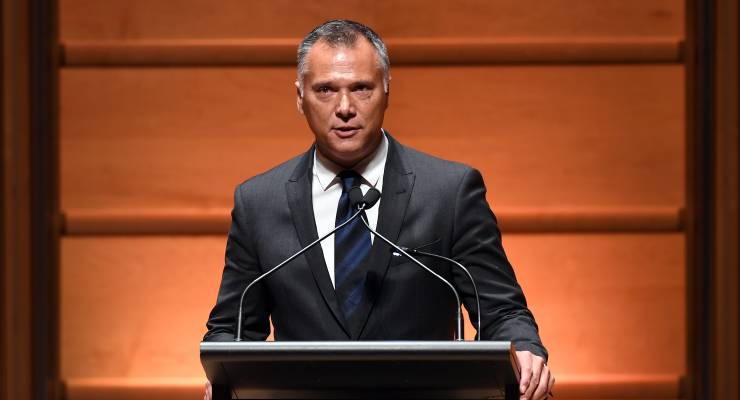
I saw a news article, and have limited social media nowadays so am not the best judge, but the announcement that Stan Grant had officially left ABC’s Q+A program seemed to barely raise notice. Perhaps because in a news cycle that has, for the last week, included Barbie and bombs, Grant making a temporary exit permanent wasn’t newsworthy.
I found the announcement sad. In many ways, when Stan published his opinion piece back in May explaining what he had been facing for years, and his pain at the inaction of those he felt should have had his back, I found it deeply relatable. Truth be told, there was a time when I did not believe I would have much in common with Stan at all, yet his sentiments hit at a time when I myself was coming out the other side of a similar quagmire.
At the beginning of his career, though Stan was always Aboriginal and was known as such, he was not an “Aboriginal journalist”. He anchored that desk at Real Life and then later at Today Tonight, going about his mainstream job in a professional manner and not ruffling feathers.
It was on his return from a long stint in China that things started to change. Through his work with NITV, he was suddenly in the driver’s seat of a lot of Indigenous news coverage and broadcasting.
Perhaps I’m petty. I will admit that when his profile started to rise dramatically in the mainstream as an Indigenous commentator, I found myself becoming agitated. This happened around the time of his famous Racism is Destroying the Australian Dream speech, which he did as part of a debate in 2015 at The Ethics Centre.
I found myself being overrun by progressive white people asking me “have you seen Stan’s speech?” and giving it massive accolades. This speech began by referencing the public bullying of Adam Goodes on the football field, then drew on Australia’s broader history of racism.
Suddenly, every time Stan spoke or wrote, he was the “talk of the town” for any progressive white person wanting to talk about racism. Yet like many other Aboriginal people who came from more activist roots, I didn’t get it. Grant, for example, often talked of Aboriginal struggle from a historical standpoint, not from the Indigenous rights perspective that I and others wrote from. His views were comparatively conservative. He talked about being locked out of the “Australian dream” by racism which must be corrected, rather than there being a deep need to overhaul this entire society through methods such as treaties and decolonisation. He appealed to “middle Australia” in a way that so many other Aboriginal people never do, through his insistence that Australia was “better than this”.
Things change. With the power of retrospect, I see parallels between the courses of Goodes and Grant. As Goodes started taking stronger stances on racism, he was punished. What I witnessed up to the coronation coverage indicates similar happened to Grant. The same white progressives who had championed Grant as “the Aboriginal voice” turned on him or stayed silent. This is to say nothing about the slurs and threats he had also received from the rabid, racist Australian underbelly for years.
As he occupied more space and became more outspoken, Stan became too much for those people. When I saw him being ripped on Twitter every time he appeared on Insiders, the complaints seemed to be that he interrupted and wouldn’t let other folks get a word in. Given some of the “luminaries” that appear on this list of panellists and their modus operandi, I have to wonder if criticism of Grant was justified, or whether the same progressive types who loved him not months earlier suddenly found themselves threatened by an “angry Black man” trope, even if that man was a highly educated and experienced one wearing a suit.
Some of Stan’s best writings have happened over the past year. Suddenly I found myself praising what Stan had expressed. Take, for example, this piece on the Voice to Parliament which raised incredibly important talking points from grassroots community members. Or this piece reflecting on the death of Queen Elizabeth II and Australian racism. There were more pieces, but the more I saw him talk about genocide, invasion, colonisation and so forth, the more relatable I found his work and the more I praised it.
Perhaps it was simply a case of time and confidence? Perhaps I was too hasty in my initial assessment and my view was always going to shift? This said, it upsets me that we are now down another Indigenous commentator in the public sphere, and one that had something different to offer, because Australia refuses to be an anti-racist space.
Grant’s long-ranging racism experience quickly got watered down to one bloke being investigated for harassment when it was so much more than this. A systemic failure cannot be undone by one man receiving a summons. If, in one hand, a media organisation holds a protest placard, and in another, a pen with which to contribute to the problem, are they ever really seeing the part they play in perpetuating racism?
For what it’s worth, I don’t think Stan and I will ever be in staunch agreement on Indigenous rights. We come from different perspectives. That’s OK. What is not OK is that yet again, Australia has lost another Indigenous perspective with which to challenge it when really it could well do to listen to as many of us as possible. Will this pattern change?








This is a great piece Celeste. Nails a lot of what the issue is here. I may or may not agree with Stan on things, or his personal style, his focus or priorities, but for me particularly the coming to a head of his critique of media, particularly around the Queens funeral , had a lot to say about the way we in Australia perceive and respond to power. Historical and contemporary. The funny thing is I was expecting much much more of the type of debate and discussion from the broader ABC. I was actually embarrassed for many of the journos to see them dressed in mourning and going through this weird out of whack obsequious discussion. My family is like most European migrant stock, but not unexposed to the reality of colonial processes in their home country…by England…it doesnt mean you hate the English people, or can’t recognise the various benefits of society, but why would you either apply a blindfold over the reality of colonisation and oppression? Historical and ongoing. So when Stan spoke up I thought…of course! It was something of a relief to see at least one journo pointing out the complicated story…surely that’s their job!? What is the big deal with what he’s saying? Surely there are more Australians out there of all backgrounds who can discern something more complex that’s required instead of forelock tugging at a time like this. Crikey even large sections of the UK can see that! But added to that the tone and relentless nature of the critique of Stan prior and during and after made me stop a look and reflect on my own responses…I still wouldn’t agree with him on many things…but really felt some visceral recognition of what he was expressing as he opened up about it. Again, a thoughtful and constructive piece. Credit to you and Stan both.
This country sucks so hard it’s taken my whole life to get my head around just how bad it sucks. Yet to see a single example of us not pissing all over anything we have going for us. It’s a lesson for the world in how to start out with everything and end up with nothing.
Good article, valid points. I had some arguments with Grant’s style of interviewing, but on the whole, he was smart, researched, and insightful on a lot of issues. His talents were wasted in Q&A. His treatment after the coronation was little more than a disgrace, and the weakness of the ABC in its defence of him was equally disgraceful.
It was relatively recently I became aware SG was Aboriginal. To me, he’s been very opinionated, sometimes I agreed with him and sometimes I didn’t. He could be overbearing in the Speerus Interruptus way, but he seems to have integrity which is to be valued in journalism. He isn’t a spear carrier for a sole cause.
What??? Did you think it was just a case of spending too long in the tanning salon? Agree with the rest of your comment, tho.
Perhaps I’m colour blind.
Thanks for this article. It is so necessary for those of us who are not First Nations people to hear different perspectives. We hear so much from Labor politicians and their fellow travellers about ‘closing the gap’ but nothing about decolonisation, treaty, truth, sovereignty, as if the ‘gap’ can be closed without those things. Good to hear Stan Grant articulating uncomfortable truths.
I hope Crikey will continue to publish different First Nations perspectives which unfortunately are not featured in mainstream media.